WHAT IS THE DIFFERENCE BETWEEN SYMMETRIC & ASSYMETRIC 2-POSTS LIFTS?
WHAT IS THE DIFFERENCE BETWEEN
SYMMETRIC- & ASYMMETRIC TWO POST LIFTS?
|
SYMMETRIC |
ASYMMETRIC |
We frequently get the question from customers, “What’s the difference between a symmetric and asymmetric two post lift ”? As a matter of fact, it’s probably the most frequent question we get.
There are several differences. Many years ago, when they first came out with two post lifts, they only made symmetric models. But they soon discovered that technicians were having difficulty getting in and out of the vehicle after they had driven in between the columns. Some bright person then came up with the idea of placing the vehicle further back, keeping about 70 percent of the car behind the columns instead of being centered. This allows the user to open the doors more completely, and exit the vehicle without having to squeeze out of a 6 inch opening. Technicians across the world rejoiced at this new asymmetric car lift design, especially the larger fellows, because it made life easier.
There still are plenty of holdouts for the symmetric design. Most modern automobiles have a majority of their weight of front, so they actually balance better when positioned on an asymmetric lift. But some autos may balance better on a symmetric lift. Any cars with engines in the rear, or vans with tools or equipment in the back, or extra long crew cab trucks for instance. Some manufacturers produce asymmetric lifts that have the ability to position the auto either way if necessary. This was a great upgrade that makes lifts safer as they can be balanced out no matter where the car’s center of gravity is located.
As long as there is a need, some innovative engineer will come out with a solution.
BendPak's Tru-Metric Design...
Offers greater versatility for greater service capabilities.
...Two Lifts in One.


Asymmetric Two Post Lifts Vs. Symmetric Two Post Lifts
This term may apply to the column configuration or to the arm configuration of a lift. This term is usually associated with lifts "that make it easy to get in and out of the car" Many lift distributors would have you believe that unless the columns are asymmetric or "turned", and the arms are asymmetrical in design, the customer would be "trapped" inside of the car. This is a ridiculous assumption.
Let us explain:
Above ground lifts originated in Europe. Cars were (and are) smaller in Europe than in the United States. Lifts could be narrower and needed to support less weight in Europe than in the United States. Service centers in the USA were largely dependent on in-ground lifts as above ground lifts were not popular in the States. In the 1980's, many of the in-ground lifts began to deteriorate and leak. These lifts needed to be replaced. Many US service centers did not want to go to the expense of "digging up" in-ground lifts and replacing them. These service centers were also concerned about environmental issues associated with in-ground lifts. Above ground lifts offered a safe and economical option to the in-ground lift with a minimum amount of "down time".
The majority of original above ground lifts were symmetrical in column and arm design. (See Symmetric)
One problem discovered when replacing an in-ground lift with an above ground lift was the overall width of the above ground lift. The width of a normal in-ground lift bay is 10 feet. The average outside column width of a symmetric above ground lift was between 11 and 12 feet. The above ground lift could not be installed between two in-ground lift bays without encroaching into the space of the neighboring in-ground lift bays.
To resolve this problem, lift manufacturers decided to reduce the overall width of above ground lifts. When the outside column width was reduced to 120 inches (ten feet), the above ground lift columns fit perfectly into the ten foot in-ground lift bay. However, the distance between the inside of these narrower columns and the symmetric arm design (all four arms are of equal length) made it very difficult to exit and enter the car.
Lift engineers designed an alternate arm configuration that would allow the above ground lift columns to be set closer together, but would allow easy access in and out of the car. Their proposed solution was to make shorter arms for the front and longer arms for the back (Asymmetric Arm Configuration). Prior to moving the car into position between the columns for lifting, all four arms would be moved to face "behind" the lift. The vehicle would pull forward between the columns until approximately 30% of the car was in front of the column and approximately 70% behind the column. The shorter arms would then be pulled forward and the lift pads would be positioned on the appropriate forward lifting points. Then the rear arms would be pulled forward to their appropriate lifting points near the rear of the vehicle. This configuration would allow the driver's front door to open wider (on most vehicles) and allow better access to the inside of the vehicle.
Some lift manufacturers soon discovered that their columns and carriages were not able to adequately support the weight that was supported at the far end of the "long" rear arms. Rather than improve the strength of the carriages or the columns, these manufacturers "turned" their columns to make the center of their columns closer to the (far end/long arm) lift pad. The "turned" (Asymmetric) columns resulted in a much narrower drive through width. The other alternative (the way we build our lifts) is to increase the strength of the columns and carriages through engineering and the addition of more steel. If the columns and carriages are built "heavy-duty", there is no need to "turn" the columns and reduce the "drive through" width. Our lifts DO NOT have the "turned" columns. Our symmetric columns ensure that the widest of vehicles can be accommodated and still allow easy entry and exit to-and-from the vehicle.
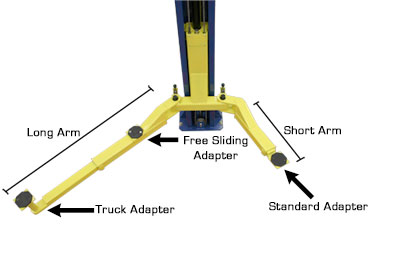
No base plate lift can be a TRUE ASYMMETRIC LIFT! A base plate lift can have short front arms and long rear arms; but this does not make the base plate lift an asymmetric lift.
To properly "load" any vehicle onto an asymmetric lift; all the arms (lift pads) need to be pointing toward the rear of the vehicle. The vehicle is moved forward between the columns and the vehicle's front wheels are positioned so that they are "just past" the front side of the columns.
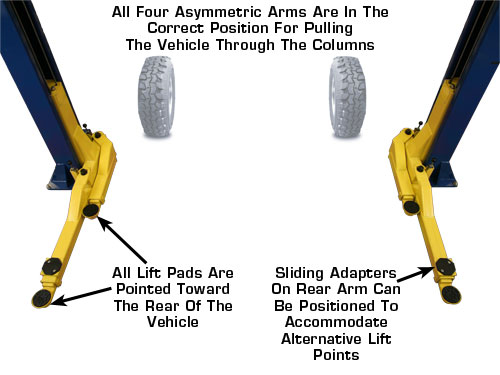
The two shorter front lift arms are then moved to about a 90 degree position to the column, and the lift pads are placed under the appropriate front lifting points of the vehicle. The two longer rear arms are then moved to allow the lift pads to extend to the rear of vehicle, and the lift pads are positioned under the correct rear lifting points of the vehicle.
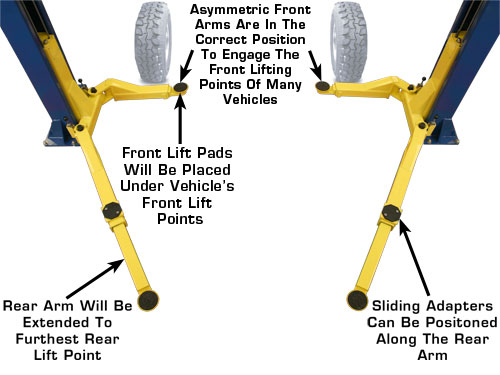
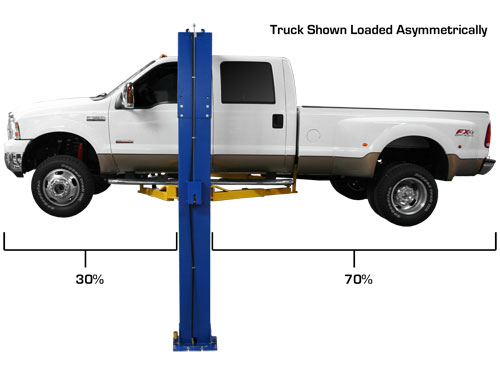
This initial positioning of the arms (all lift pads pointing to the rear of the vehicle) CAN ONLY be accomplished on an overhead style above ground two post lift. The front arm pads could not be moved to face the rear of the vehicle if there was a raised metal plate on the floor between the two columns. The shorter front arms could only be positioned in an asymmetric lift configuration if the arm carriages were raised high enough to allow the two front arms to "clear" the base plate when moved to face the rear of the vehicle. If the arms were raised higher in the air, then the lift pads would be too high to clear the underside of many "low slung" or average height vehicles.
Symmetric:
This term can apply to both the arms and the columns of a lift. Symmetric Arms can be extended or collapsed so that all four arms are the same length. You can adjust symmetric arms to become "somewhat" asymmetrical, but symmetric arms are primarily designed to lift the vehicle "in the middle". If you are lifting pick-up trucks, vans, or any type of "longer" vehicle with a "load" in the rear, then the symmetric form of lifting is the preferred method.
Symmetric columns are installed so that the middle of the columns are positioned directly across from each other for the greatest amount of "drive through" space. The inside width of our symmetric lifts allows easy access either in or out of a vehicle.
Our lift arm configurations include symmetric, asymmetric, or arms that offer a combination of both (asymmetric/symmetric) or super symmetric.
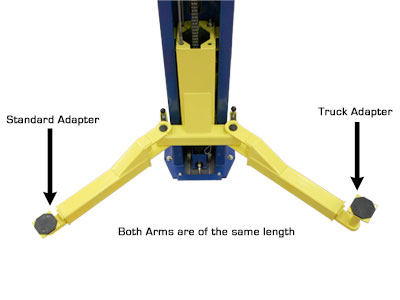
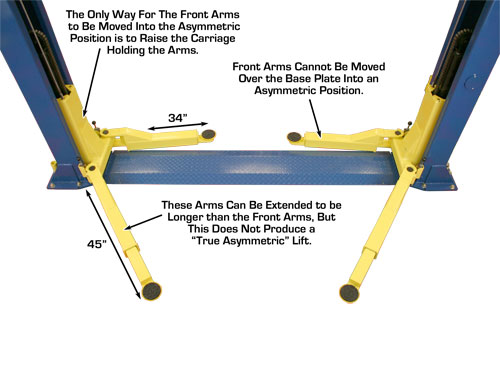
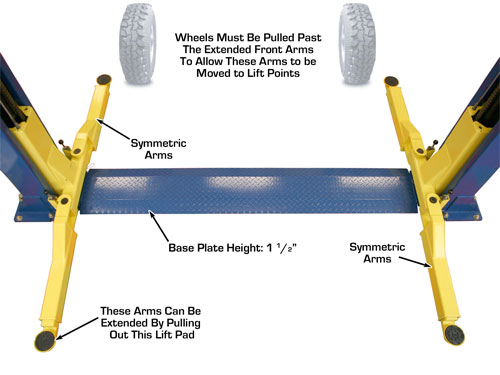
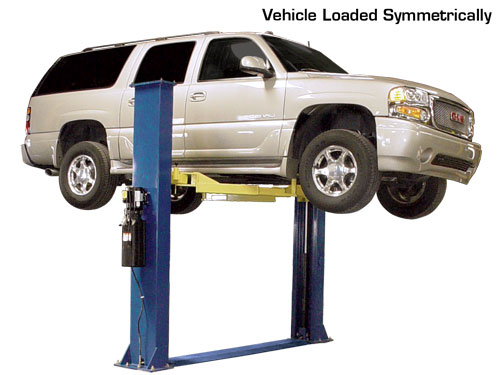
As discussed in the comparison between overhead and base plate lifts; the overhead two post lift offers more stability than the base plate two post lift because of the overhead beam between the columns. This is very important reason why ONLY OVERHEAD two post lifts should be used to lift heavier vehicles in an a "TRUE" asymmetric configuration (30/70).
The weight of a vehicle must be evenly distributed on a two post lift. The operator must remember that whether the vehicle is lifted either in a symmetric or asymmetric configuration, the weight of the vehicle must be evenly distributed on each of the four arms.
The old myth that two post lifts, with symmetric arm configurations, will "not let the operator get out the car" is unfounded. If you want to learn how to position a vehicle between the columns of a two post lift with symmetric arms and still be able to open the driver's door; then call the lift professionals at Greg Smith Equipment Sales for all the answers.
Super Symmetric:
This term is used to describe the arm configuration of many of our Atlas® lifts. Super Symmetric (SS) arms have three (3) stage front arms and two (2) stage rear arms. The arms can be configured so that they are parallel to each other. The front arms CANNOT be turned completely toward the rear of the vehicle (like the front asymmetric arms). However, because the three (3) stage front arms can collapse to a shorter length than two (2) stage arms, it is easier to position the lift pads on the front arms under the correct lifting points of many short wheel base vehicles.
The front arms collapse to be short (small cars) and then extend fully to complement the rear arm length when lifting a longer wheel base vehicle (pick up trucks).
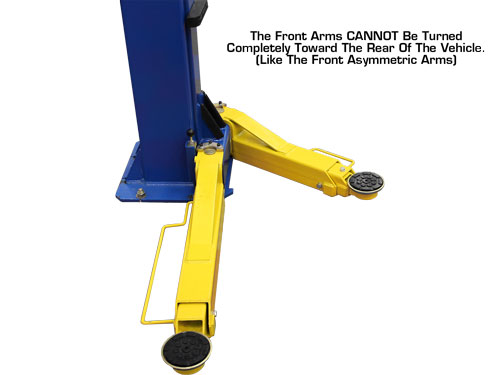
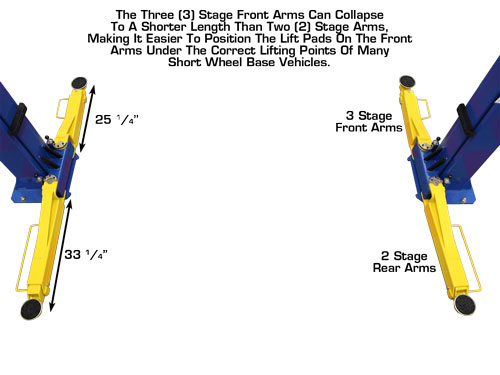
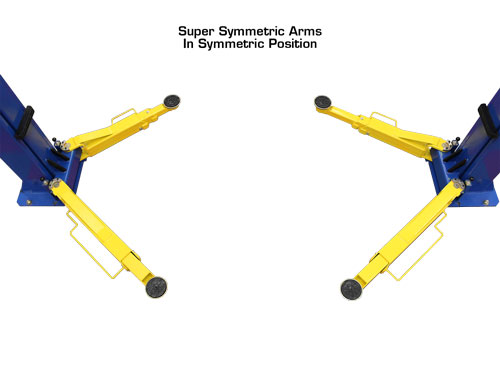
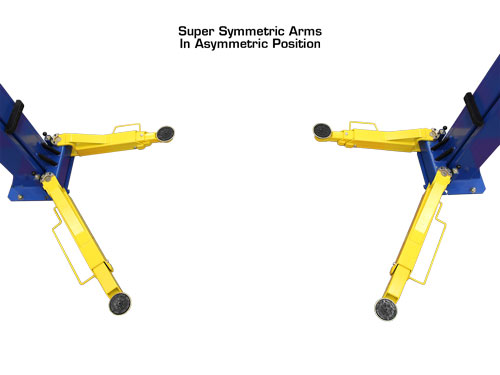
TWO POST LIFTS
Two Post Lifts Concrete Requirements
| Lifting Capacity | Concrete Thickness | PSI of the Concrete |
| 7,000-10,000 lbs | Minimum 4" | 3,000-PSI |
| 12,000-15,000 lbs | Minimum 6" | 3,000-PSI |
| 18,000 lbs | Minimum 8" | 3,000-PSI |
Off set adapters for 2-Post Car Lifts
Apply for Financing now! No obligation by Applying.
Instant Credit Decisions for ALL your Automotive Lifts and Shop Equipment needs!
Click  for Finance/Lease Application Secure & Confidential
for Finance/Lease Application Secure & Confidential
24/7 Instant approvals, Start up Business, Low Credit Score OK. 
The Tool Connection Since 1984 ![]() 203-813-0414
203-813-0414
Automotive Lifts & Shop Equipment since 1984
Satisfaction Guaranteed





